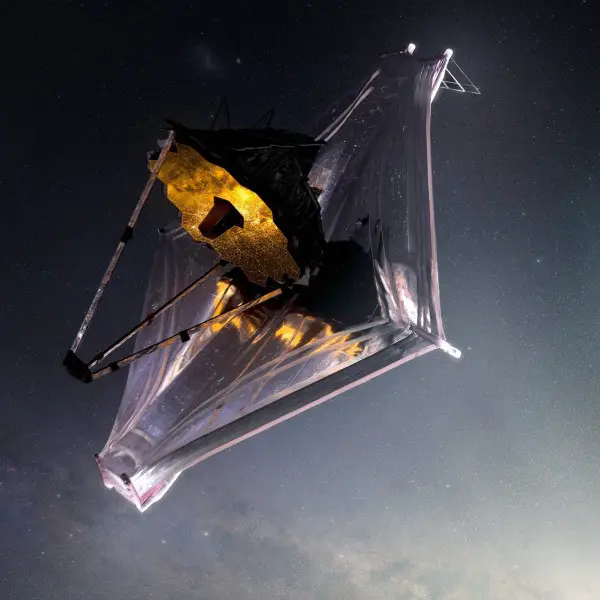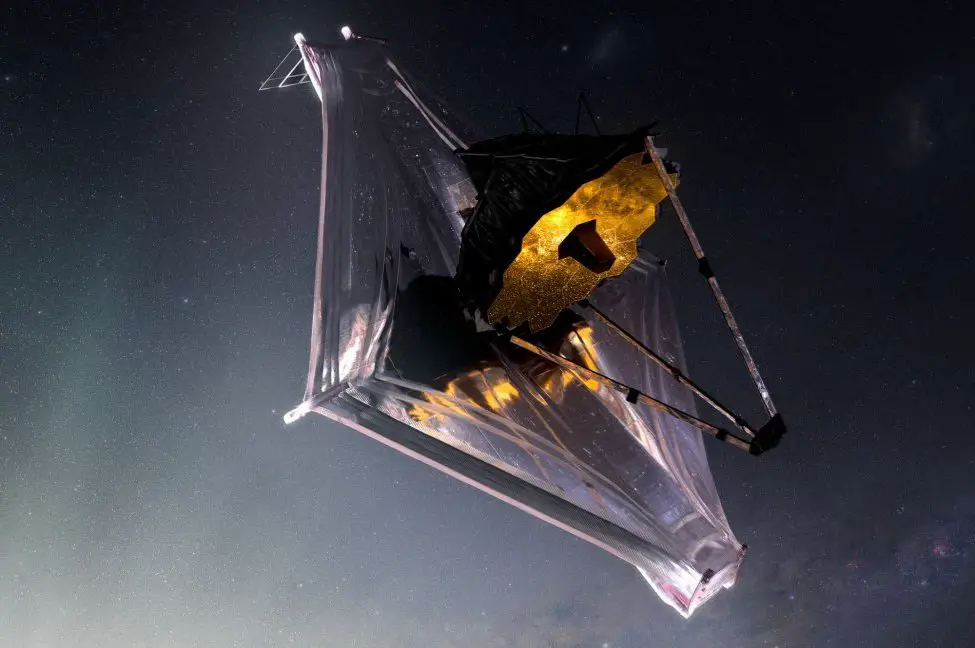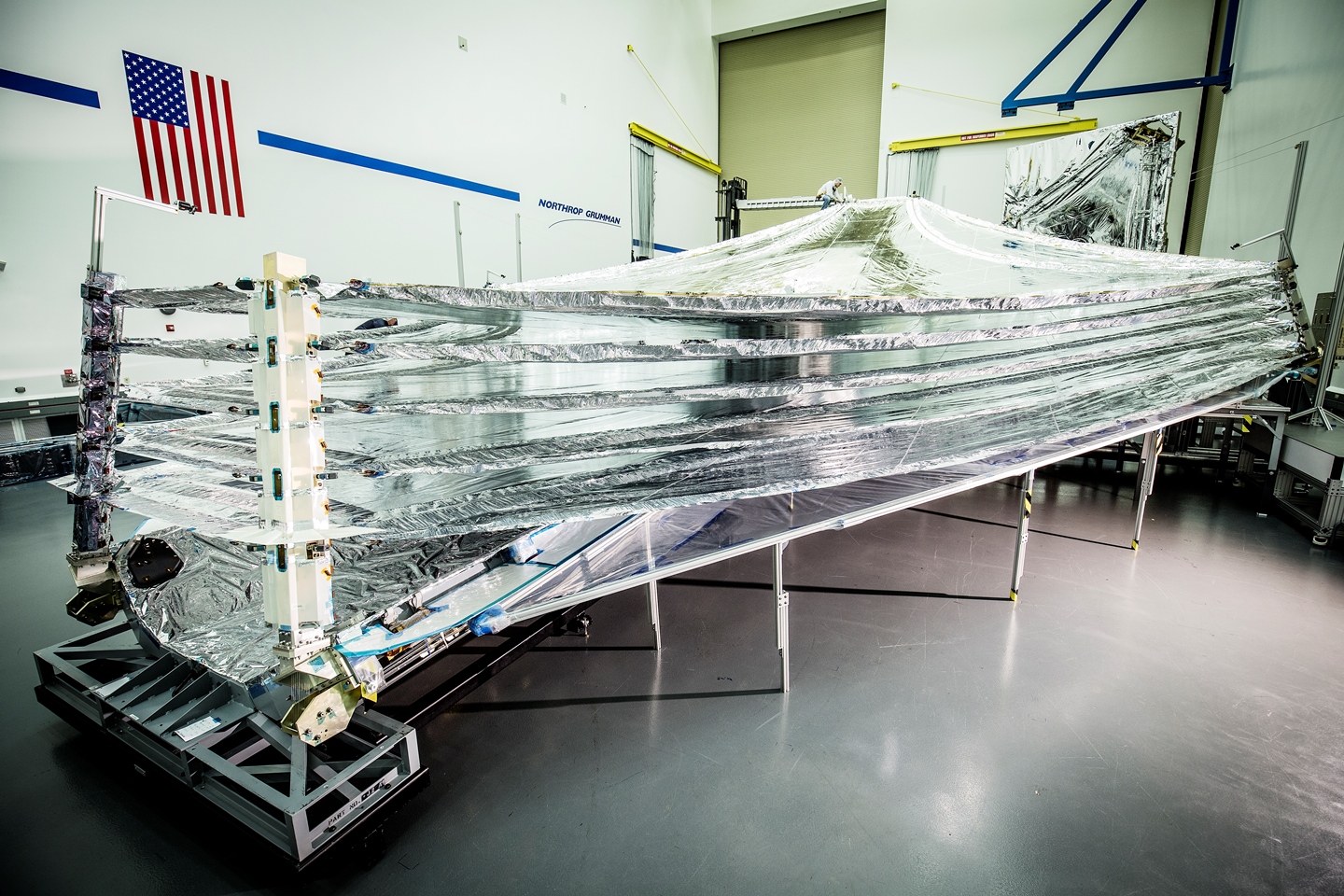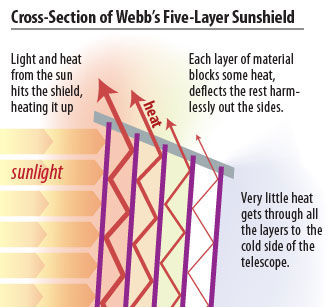The sunshield on NASA’s next-generation James Webb Space Telescope has been successfully deployed, a vital component that will keep the observatory’s equipment exceptionally cool throughout its mission. The sunshield’s unfurling completes possibly the most difficult deployment the observatory must complete in order to operate correctly while in orbit.

After the deployment, Bill Ochs, the project manager for JWST at NASA’s Goddard Space Flight Center, told the mission team, “This is a tremendously momentous moment.” “I simply want to congratulate everyone on a job well done.” There is still a lot of work to be done, but having the sunshield out and deployed is huge.”
After about 25 years of construction, NASA’s powerful new space observatory, the James Webb Space Telescope, or JWST, was launched on December 25th. JWST is widely regarded as the successor of the Hubble Space Telescope, which is presently orbiting Earth.
It promises to deliver considerably more power and a better capacity to observe distant, dim objects in our Universe. JWST will be used by astronomers to go back in time and observe some of the earliest stars and galaxies that formed only a few hundred million years after the Big Bang.
However, before JWST can study the early Universe, it must first go through a lengthy unfolding process. Because the telescope was considered too big to send into orbit in its final shape, mission planners designed it to unfurl after launch.
This is it: we’ve just wrapped up one of the most challenging steps of our journey to #UnfoldTheUniverse.
With all five layers of sunshield tensioning complete, about 75% of our 344 single-point failures have been retired! pic.twitter.com/P9jJhu7bJX
— NASA Webb Telescope (@NASAWebb) January 4, 2022
Hundreds of mechanisms and moving components are involved in the deployment, and everything must work well for JWST to operate. There are up to 344 single-point failures along the road, which are deployments without backups that must go as planned or the operation would be jeopardized.
THE FINAL STAGE OF PERHAPS THE MOST DIFFICULT DEPLOYMENT
The deployment of JWST’s sunshield was a part of the unfolding process. Infrared light, a form of invisible light linked with heat, is seen by JWST. As a result, the telescope must operate at a very low temperature, about -370 degrees Fahrenheit, in order to perform effectively. The sunshield, which is made up of five thin reflecting layers of a material called Kapton, is meant to keep the telescope from overheating.
The sunshield’s deployment was a difficult task since the layers are very thin membranes that had to stay intact. The layers were unfurled using up to 107 release mechanisms, each of which had to function properly in order for the sunshield to fully expand. After the layers unfolded, the spaceship had to bring them tight, much to how sails on a sailboat are drawn taut.
The sunshield installation took a little more than a week, which was a little longer than expected. NASA had estimated that the procedure would take roughly six days, but the JWST crew took a break over the New Year’s weekend to recuperate and review the data coming in from the satellite.
They also had to deal with a few challenges along the road as a result of some unexpected temperature readings and equipment malfunctions. “With the telescope, we are still in the getting-to-know-you phase,” Ochs stated at a news briefing the day before deployment finished. “Orbital satellites will always be a little different in orbit than they are on the ground,” says the author.
“WITH THE TELESCOPE, WE ARE STILL IN THE GETTING-TO-KNOW-YOU PHASE.”
The first issue was a minor malfunction with JWST’s solar arrays, which supply the electricity that the telescope need to operate. The solar arrays’ power output was limited by factory default, but Northrop Grumman rebalanced them depending on the temperatures they were experiencing in orbit.
That seems to have resolved the issue, and JWST is now receiving sufficient power to work correctly. The motors used to remove the sunshield and aid tension the layers were also a problem. They were a little hotter than the JWST team had anticipated, so mission engineers reoriented the observatory slightly to limit the amount of sunlight reaching them. This allowed the motors to cool down before their intended usage.

Some of the most nerve-wracking moments of JWST’s deployment are behind us now that the sunshield has been unfolded. According to NASA, 70 to 75 percent of single-point failures have been formally accomplished. During the press briefing, Ochs noted, “That is tremendous within the first week and a half or so of the spacecraft being in service.”
However, the telescope has yet to reach other significant milestones. Notably, pieces of the observatory’s primary mirror, which will be used to capture light from distant galaxies and stars, have yet to be deployed. That critical event is scheduled to take place in about a week, and it, like all previous deployments, must go off without a hitch in order for JWST to complete its mission.
How a Shield Protects NASA’s James Webb Telescope From the Sun?
The James Webb Space Telescope will mainly study the infrared light emitted by dim and faraway objects. The telescope itself must be kept exceedingly cold in order to detect those weak heat signals.
Webb includes a 5-layer, tennis court-sized sunshield that works as a parasol giving shade to protect the telescope from external sources of light and heat (such as the Sun, Earth, and Moon) as well as heat created by the observatory itself. [Actual dimensions: 69.5 ft x 46.5 ft, 21.197 m × 14.162 m]
This sunshield will always be between the telescope and the Sun/Earth/Moon. JWST will circle the Sun 1.5 million kilometers distant from (but almost in line with) the Earth, allowing it to be positioned in this manner.
By passively venting its heat into space, the sunshield will enable the telescope to drop to a temperature below 50 Kelvin (-370°F, or -223°C). Through a passive cooling system, the near-infrared instruments (NIRCam, NIRSpec, FGS/NIRISS) will operate at about 39 K (-389°F, -234°C). Using a helium refrigerator, or cryocooler system, the mid-infrared instrument (MIRI) will operate at a temperature of 7 K (-447°F, -266°C).
The sunshield not only creates a cool environment, but also one that is thermally stable. This is necessary to keep the primary mirror segments in appropriate alignment while the telescope rotates around the Sun.
Why is the sunshield made up of five layers rather than a single thick one?
Each layer of the sunshield below is colder than the one before it. The heat escapes via the gaps between the layers, and the vacuum between them acts as an excellent insulator. More than five layers separated by vacuum would transfer heat from the bottom to the top of a single large thick sunshield.
The sunshield is constructed of Kapton, a lightweight polymer with excellent thermal qualities that has been specifically treated.
The layers combine to lower the temperature difference between the hot and cold sides of the observatory by around 570 degrees Fahrenheit. Each subsequent layer of the kapton sunshield is cooler than the one before it. The fifth and final layer was delivered to Northrop Grumman Corporation’s Space Park facility in Redondo Beach on September 29, 2016. Northrop Grumman (photo credit: Northrop Grumman)
IN DETAIL
The five-layer sunshield’s gleaming silver substance is a sophisticated and creative material science and engineering marvel. Each layer is built of a different composite material, has a different thickness and dimension, and must be spaced exactly. To prevent meteorite damage, specific seams and reinforcements have been included.

In the material that makes up the sunshield, NASA and its industry partners devised a lightweight, strong approach to protect the telescope and mirrors from the sun’s infrared radiation. The sunshield’s robust but ultra-thin material, unusual kite-like design, and particular function of its layers are just a few of the features that set it apart.
Make-up Materials
The sunshield is made up of five layers of Kapton material. Each layer is aluminum-coated, with a “doped-silicon” (or treated silicon) coating on the sun-facing side of the two hottest layers (named Layer 1 and Layer 2) to reflect the sun’s heat back into space.
Because the infrared cameras and equipment onboard must be kept extremely cold and out of the sun’s heat and light to work correctly, the sunshield is an important feature of the Webb telescope.
Kapton is a polyimide film that DuPont developed in the late 1960s. It has a great heat resistance and can withstand temperatures ranging from minus 269 to + 400 degrees Celsius (minus 452 to plus 752 degrees Fahrenheit). Even at these extreme temperatures, it does not melt or burn. Kapton polyimide film is utilized in a wide range of electrical and electronic insulating applications on Earth.
For optical characteristics and lifespan in the space environment, the sunshield layers are additionally coated with aluminum and doped silicon. Doping is a procedure that involves mixing a little quantity of another material into the Silicon coating process to make it electrically conductive.
The coating must be electrically conductive in order for the Membranes to be electrically grounded to the rest of JWST and to prevent a static electric charge from accumulating on their surface. Silicon has a high emissivity, which means it emits the most heat and light and functions as a barrier between the sun’s heat and the infrared sensors that will be placed underneath it.
The highly reflective metal surfaces also deflect any residual energy away from the sunshield layer’s borders.
Layers And A Kite-Like Shape
On the telescope, the kite-like design and the number of layers of sunshield both play a significant role. To achieve their job, each of the layers is precisely positioned and separated.

“The form and architecture of the James Webb Space Telescope Sunshield help direct heat out the sides, around the perimeter, and between the layers,” said James Cooper, James Webb Space Telescope Sunshield Manager at NASA’s Goddard Space Flight Center in Greenbelt, Maryland. “Heat created by the Spacecraft bus in the “core,” or center, is pushed out between the membrane layers, preventing the optics from being heated.”
“The five layers are necessary to block and re-direct enough heat to bring the telescope down to acceptable temperatures with a margin of safety,” Cooper said. “The fifth layer is primarily used as a buffer against flaws, micrometeoroids, and other hazards.” The space between the layers acts as an extra insulator.
The sunshield’s layers are very thin. The first layer, which will face the sun, is just 0.05 millimeters thick (0.002 inches), whereas the next four layers are 0.025 millimeters thick (0.001 inches). The aluminum and silicon coatings have even thinner layers. The silicone coating is 50 nanometers thick (1.9 microinches) while the aluminum coating is 100 nanometers thick (3.93 microinches).
The layers are somewhat diverse in size and form. The lowest layer is Layer 5 (immediately under the main mirror), while the greatest layer is Layer 1. The first layer is rather flat, whereas the fifth layer is more curved. To transfer heat from the center to the edges of the layers, the layers are closer together in the center and wider apart at the margins.
The maximum temperature of Layer 1 is 383K, according to thermal models. Layer 5 has a maximum temperature of 221K and a low temperature of 36K.
The optics of the telescope (such as the infrared camera and mirrors) must always be shielded from direct contact with any hot objects. As a result, the membranes are sized and placed in such a manner that the mirrors only have a direct line of sight to the chilly Layer 5, whereas the sun only shines directly on Layer 1 regardless of which direction the observatory is pointing.
Seaming with a twist
Although the membrane material is durable, a little rip or hole in it may quickly grow into a much bigger hole. As a result, a specific procedure is known as Thermal Spot Bond (TSB) – places where each layer is fused together – has been developed. In addition, around every 6 feet or so, reinforcing strips of membrane material are Thermal Spot Bonded to the parent membrane, providing a grid pattern of “rip-stops.”
“This has been proved in tests to stop a tear from spreading beyond of a certain grid area,” Cooper said. As a result, if a hole in the sunshield arises as a result of a meteoroid or tiny meteor, the damage is reduced. These are not meant to halt a meteoroid; rather, they are meant to confine the damage.
The Sunshield And Extreme Temperatures
The sunshield material shrinks as the temperature drops, while the heated layers expand. Cooper said, ” “When compared to other materials, the Kapton variant reduces this. We have had the material tested to see how much it shrinks. We take this into consideration in both our manufacture and our research of the form we will take in space. To confirm our predictions, we tested a one-third-scale five-layer sunshield at temperature and vacuum.”
A video of sunshield deployment testing may be seen below.

